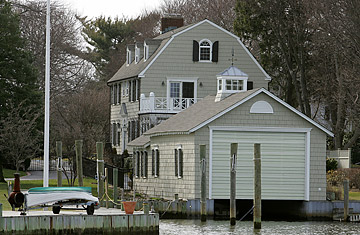Sundarbans
সুন্দরবন বঙ্গোপসাগরে পদ্মা, ব্রহ্মপুত্র এবং মেঘনা নদীর সঙ্গম দ্বারা গঠিত বদ্বীপের একটি ম্যানগ্রোভ এলাকা। এটি বাংলাদেশের খুলনা বিভাগের বালেশ্বর নদী থেকে ভারতের পশ্চিমবঙ্গ রাজ্যের হুগলি নদী পর্যন্ত বিস্তৃত। এটি বন্ধ এবং উন্মুক্ত ম্যানগ্রোভ বন, কৃষি কাজে ব্যবহৃত জমি, মাটিফ্লাট এবং অনুর্বর জমি নিয়ে গঠিত এবং একাধিক জোয়ার -ভাটা ও চ্যানেল দ্বারা ছেদিত। সুন্দরবনের চারটি সুরক্ষিত এলাকা ইউনেস্কোর বিশ্ব itতিহ্যবাহী স্থান হিসেবে তালিকাভুক্ত হয়েছে, যেমন। সুন্দরবন পশ্চিম (বাংলাদেশ), সুন্দরবন দক্ষিণ (বাংলাদেশ), সুন্দরবন পূর্ব (বাংলাদেশ) এবং সুন্দরবন জাতীয় উদ্যান (ভারত)। [3]
এই সুরক্ষা সত্ত্বেও, IUCN রেড লিস্ট অফ ইকোসিস্টেমস ফ্রেমওয়ার্কের অধীনে ২০২০ সালের মূল্যায়নে ভারতীয় সুন্দরবন বিপন্ন বলে বিবেচিত হয়েছিল। [4] সুন্দরবন ম্যানগ্রোভ বন প্রায় 10,000 কিমি 2 (3,900 বর্গ মাইল) এলাকা জুড়ে রয়েছে, যার মধ্যে বাংলাদেশের খুলনা বিভাগের বন 6,017 কিমি 2 (2,323 বর্গ মাইল) এবং পশ্চিমবঙ্গে 4,260 কিমি 2 (1,640 বর্গ মাইল) জুড়ে বিস্তৃত। দক্ষিণ ২ Par পরগনা এবং উত্তর ২ Par পরগনা জেলা। [5] সর্বাধিক প্রচুর গাছের প্রজাতি হল সুন্দরী (হেরিটিয়ারা ফোমস) এবং গেওয়া (এক্সকোইকারিয়া আগালোচা)। বনগুলি 3৫3 টি প্রাণী, 29০ টি পাখি, ১২০ টি মাছ, ma২ টি স্তন্যপায়ী, rep৫ টি সরীসৃপ এবং আটটি উভচর প্রজাতির বাসস্থান সরবরাহ করে। [6] মাছ এবং কিছু অমেরুদণ্ডী প্রাণী ছাড়া অন্য সকল বন্যপ্রাণী হত্যা বা ধরার উপর সম্পূর্ণ নিষেধাজ্ঞা থাকা সত্ত্বেও, দেখা যাচ্ছে যে বিংশ শতাব্দীতে হ্রাসপ্রাপ্ত জীববৈচিত্র্য বা প্রজাতির ক্ষয়ক্ষতির ধারাবাহিক প্যাটার্ন রয়েছে এবং বনের পরিবেশগত মান হ্রাস পাচ্ছে। [ 7]
উভয় সরকারের কাছ থেকে সংরক্ষণের প্রতিশ্রুতি সত্ত্বেও, সুন্দরবন প্রাকৃতিক এবং মানবসৃষ্ট উভয় কারণে হুমকির মুখে রয়েছে। ২০০ 2007 সালে ঘূর্ণিঝড় সিডরের ভূমিধসে সুন্দরবনের প্রায় %০% ক্ষতিগ্রস্ত হয়। জলবায়ু পরিবর্তনের কারণে সমুদ্রপৃষ্ঠের উচ্চতা বৃদ্ধি এবং মিঠা পানির সরবরাহ কমে যাওয়ায় বনটি লবণাক্ততা বৃদ্ধিতেও ভুগছে। ২০০ 2009 সালের মে মাসে ঘূর্ণিঝড় আইলা ব্যাপক হতাহতের সাথে সুন্দরবনকে বিধ্বস্ত করে। কমপক্ষে 100,000 মানুষ এই ঘূর্ণিঝড়ে ক্ষতিগ্রস্ত হয়েছিল। [8] [9] বাংলাদেশের খুলনার বাগেরহাট জেলার রামপাল উপজেলায় সুন্দরবনের 14 কিলোমিটার (8.7 মাইল) উত্তরে অবস্থিত প্রস্তাবিত কয়লাভিত্তিক রামপাল বিদ্যুৎ কেন্দ্রটি ইউনেস্কোর 2016 সালের রিপোর্ট অনুযায়ী এই অনন্য ম্যানগ্রোভ বনকে আরও ক্ষতিগ্রস্ত করবে বলে আশা করা হচ্ছে। [10] জলবায়ু পরিবর্তন উভয়ই এই অঞ্চলের প্রাকৃতিক ব্যবস্থা এবং মানুষের জনসংখ্যা উভয়কেই নেতিবাচকভাবে প্রভাবিত করবে বলে আশা করা হচ্ছে, যার ফলে আরও বাস্তুতন্ত্রের অবক্ষয় এবং জলবায়ু স্থানান্তর হবে। এই অঞ্চলটি পরীক্ষা করে দেখা বিশেষজ্ঞরা ম্যানগ্রোভ পুনরুদ্ধার এবং ব্যবস্থাপনার উপর আরও মনোযোগ দেওয়ার সুপারিশ করেন এবং পরিচালিত পশ্চাদপসরণ এবং স্থিতিস্থাপক অবকাঠামোতে বিনিয়োগের মতো প্রক্রিয়ার মাধ্যমে মানুষের জনসংখ্যার অভিযোজন করার পরামর্শ দেন।
Etymology[edit]
The literal meaning of Sundarbans (Bengali: সুন্দরবন, romanized: Sundôrbôn) is "beautiful forest". Alternatively, it was proposed that the name is a corruption of Samudraban, Shomudrobôn ("Sea Forest"), or Chandra-bandhe, the name of a tribe.[12] However, the likely origin of the word is Sundari or Sundri, the local name of the mangrove species Heritiera fomes abundant in the area.[13]
History[edit]
The history of human settlement in the Sundarbans area can be traced back to Mauryan era (4th-2nd century BCE).[14] A ruin of an abandoned city was found in the Baghmara Forest Block that is attributed to Chand Sadagar, a pre-Mauryan semi-historical figure in Bengali folklore.[15] Archaeological excavation at Kapilmuni, Paikgacha Upazilla, north of the Sundarbans in Bangladesh, revealed ruins of urban settlement dating back to the early middle ages.[16] During the Mughal period, forest tracts were leased out by the local rulers for establishing settlements.[15] In 1757, The British East India Company obtained proprietary rights over Sundarbans from the Mughal Emperor Alamgir II and completed mapping the area in 1764. However, systematic forest management started a century later. The first Forest Management Division to have jurisdiction over the Sundarbans was established in 1869. In 1875 a large portion of the mangrove forests was declared as reserved forests under the Indian Forest Act of 1865 (Act VIII of 1865). The remaining portions of the forests were declared a reserve forest the following year and the forest, which was so far administered by the civil administration district, was placed under the control of the Forest Department. A Forest Division, which is the basic forest management and administration unit, was created in 1879 with the headquarters in Khulna, Bangladesh. The first management plan was written for the period 1893–98.[17][18]
In 1911, Sundarbans was described[by whom?] as a tract of waste country that had never been surveyed nor had the census been extended. At this time, the forest stretched for about 266 kilometres (165 mi) from the mouth of the Hooghly River to the mouth of the Meghna River and was bordered inland by the three settled districts of the 24 Parganas, Khulna and Bakerganj. The total area (including water) was estimated at 16,900 square kilometres (6,526 sq mi).











No comments